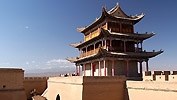Shaoxing, CHINA, May 31, 2011 – The city of Shaoxing in Zhejiang Province is 2,500 years old and has played a key role as a political, economic, and cultural center throughout the centuries. However, the city has gradually been losing its historic attributes and the potential to generate social and economic benefits from these assets.
Jin Caijuan lives next to an ancient canal in one of the city’s five remaining traditional neighborhoods that offer a waterside lifestyle. But for years, Jin and her neighbors have been paying the price of living in an ancient urban area: lack of sanitation facilities, deteriorating public services, and poor environmental conditions.
The World Bank-supported Zhejiang Urban Environment Project began addressing these issues in 2004. Jin’s house, which was built during the Ming Dynasty (1368 to 1644 A.D.), has benefited from a residential upgrading program that repaired windows, doors, and roofs. The project also connected each house to sewer pipes and upgraded electrical and telecommunication lines. Twenty kilometers of the city’s canals also were refurbished to increase the water flow and quality.
Jin is one of about 26,000 people living in Shaoxing’s inner city neighborhoods who have benefited from this project. “Life is getting better year by year,” she says. “The house itself has been restored and the surrounding environment has been improved a lot.”
Integrating Conservation into Development
The Zhejiang Urban Environment Project is intended to strengthen the collection and treatment of wastewater and improve urban infrastructure services, including the rehabilitation of inner waterways, lakes, and roads in Shaoxing.
For Shaoxing, which is one of China’s best known historical and cultural cities, “the project integrated cultural heritage conservation into urban development,” says Axel Baeumler, a Senior Infrastructure Economist at the World Bank who leads the project. “This is a very innovative concept for urban development in China, challenging the conventional thinking that new development means demolishing the old.”
In Shaoxing, the project focuses on conserving cultural heritage sites, repairing housing, and maintaining the characteristics of the old town, as well as improving basic infrastructure and residents’ standard of living.
For 74-year-old Chen Mingzhao, who has lived in the old town all his life, the project has meant “drastic changes.” “From my old house, now I can browse news on the websites of foreign countries and chat with relatives living far from here,” he says. “Also, after the rebuilding of the main street, there are more shops and more businesses, more tourists and more income.”
Boosting Tourism
Each year, Shaoxing’s rich cultural heritage attracts millions of visitors. Over 10 percent of the residents in the old town earn their living from tourism, including making souvenirs, providing food and hotel services, and acting as guides. Consequently, the World Bank supported the development of a sustainable tourism project, which has financed construction of a new state-of-the-art municipal museum to house Shaoxing’s world-class collection of artifacts.
Chen Jing, who sells traditionally made yellow rice wine in the old town, says her business has grown rapidly since the upgrading and conservation work. “The street will be even more attractive when there are more businesses selling traditional Chinese products here,” she says.
Since the early 1990s, the Bank has developed 12 projects in China supporting cultural heritage conservation through more than US$1.3 billion in financing that includes about US$260 million specifically for cultural heritage conservation. These figures make it the largest single-country program supporting cultural heritage conservation at the World Bank.
Creating a Model
Shaoxing is one of more than 100 Historical Cities designated by China’s State Council. “What has been achieved in Shaoxing could be a model for other cities. We have improved the livelihoods of the local residents, while keeping history alive.” says Li Bo, director of Shaoxing’s Historical Cultural City Management Office.
“The most important thing to come from the project is a raised awareness in Shaoxing of the importance of cultural heritage conservation and the value of a long-term strategy,” says Xuan Chuanzhong, head of the Cultural Relics Bureau and Tourism Commission of Shaoxing. “In Shaoxing this has meant preserving the urban fabric of whole traditional neighborhoods, rather than just one major historic building in an area.”
“I like living in the old town, it is much nicer than living in the modern part of the city. Life is easy, and it is nice and green here,” says Jin Caijuan.

